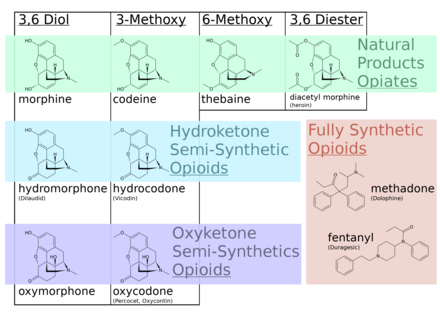The opioid epidemic, also referred to as the opioid crisis, is the rapid increase in the overuse, misuse/abuse, and overdose deaths attributed either in part or in whole to the class of drugs called opiates/opioids since the 1990s. It includes the significant medical, social, psychological, demographic and economic consequences of the medical, non-medical, and recreational abuse of these medications.


Opioids are a diverse class of moderate to strong painkillers, including oxycodone (commonly sold under the trade names OxyContin and Percocet), hydrocodone (Vicodin, Norco), and fentanyl (Abstral, Actiq, Duragesic, Fentora), which is a very strong painkiller that is synthesized to resemble other opiates such as opium-derived morphine and heroin.[2] The potency and availability of these substances, despite the potential risk of addiction and overdose, have made them popular both as medical treatments and as recreational drugs. Due to the sedative effects of opioids on the respiratory center of the medulla oblongata, opioids in high doses present the potential for respiratory depression and may cause respiratory failure and death.[3]
Opioids are highly effective for treating acute pain,[4] but there is strong debate over whether they are effective in treating chronic or high impact intractable pain,[5] as the risks may outweigh the benefits.[5]
- ^ Fentanyl. Image 4 of 17. US DEA (Drug Enforcement Administration). See archive with caption: "photo illustration of 2 milligrams of fentanyl, a lethal dose in most people".
- ^ "Opioids". Drugs of Abuse. National Institute on Drug Abuse. Archived from the original on July 26, 2019. Retrieved July 29, 2019.
- ^ "Opioid overdose". World Health Organization. August 4, 2021. Archived from the original on December 1, 2014.
- ^ Alexander GC, Kruszewski SP, Webster DW (2012). "Rethinking Opioid Prescribing to Protect Patient Safety and Public Health". JAMA. 308 (18): 1865–1866. doi:10.1001/jama.2012.14282. PMID 23150006.
- ^ a b Franklin GM (September 29, 2014). "Opioids for chronic noncancer pain: A position paper of the American Academy of Neurology". Neurology. 83 (14): 1277–1284. doi:10.1212/WNL.0000000000000839. PMID 25267983.